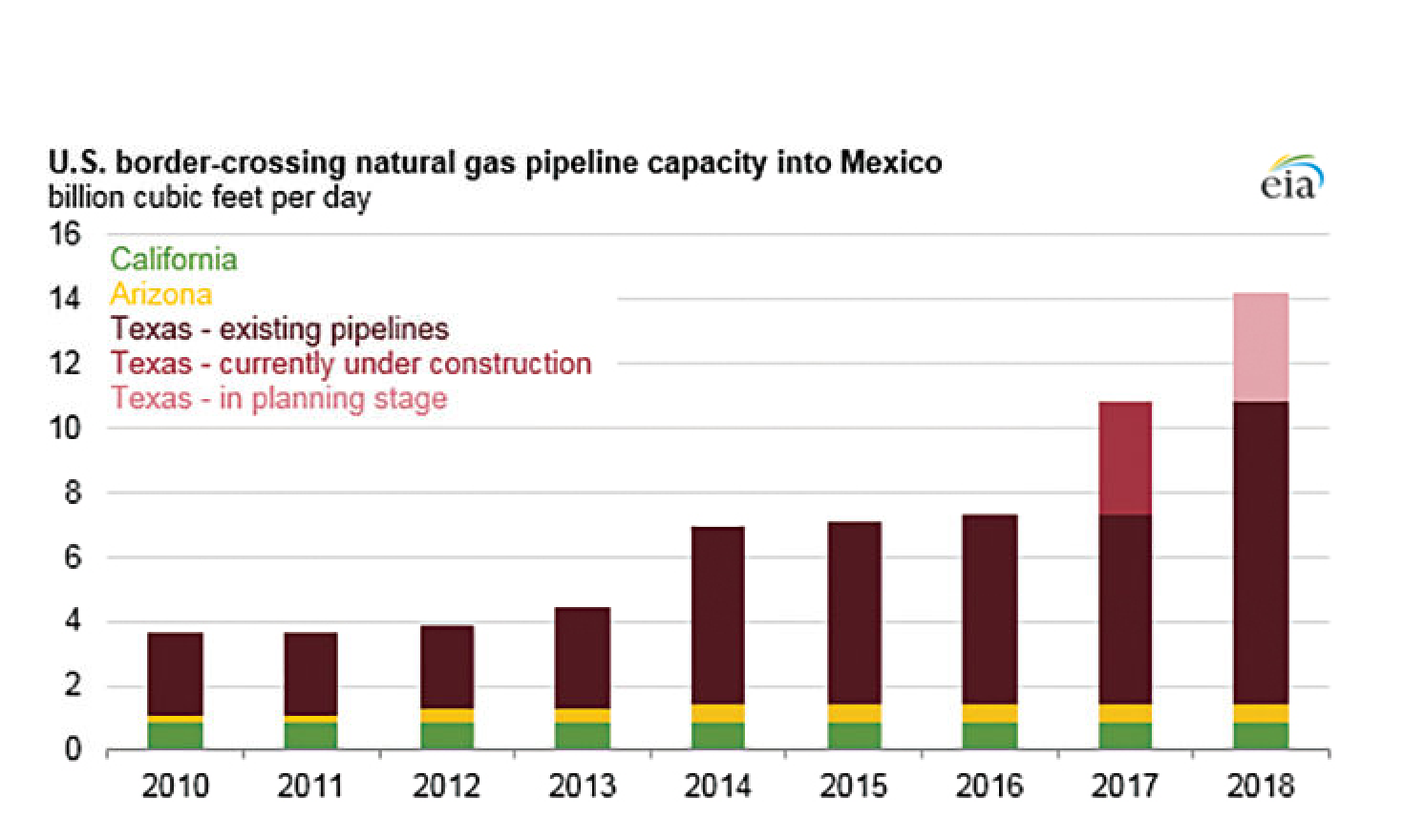August 2017, Vol. 244, No. 8
General
New Border-Crossing Pipelines Bring Shale Gas to Mexico

The expansion of the U.S. cross-border pipeline network into Mexico since that nation’s historic Energy Reform in 2014 has been driven primarily by strong growth in Mexico’s natural gas demand in the power sector, declining domestic production, and the lower prices of U.S. pipeline gas compared with more expensive LNG imports.
In the next three years, U.S. pipeline capacity into Mexico will nearly double. In recent developments, Mexico announced a new joint venture with TransCanada to build and operate a $2.1 billion natural gas pipeline. TransCanada is working on two other new pipelines in Mexico as well.
The 497-mile (800-km), Sur de Texas-Tuxpan pipeline is expected to be in-service in the second half of 2018 and will be 40% owned by Sempra. The 42-inch pipeline will begin near Brownsville, TX in the Gulf of Mexico, and terminate in Tuxpan, Veracruz. The pipeline will interconnect with projects from CENAGAS, Tanazychale and Tuxpan-Tula.
“This new project brings our footprint of existing assets and projects in development in Mexico to more than $5 billion, all underpinned by 25-year agreements with Mexico’s state power company,” Russ Girling, CEO and president of TransCanada, told The Financial Post.
In 2017, four U.S. pipeline projects under construction – Roadrunner (Phase II), Comanche Trail, Presidio Crossing (also called Trans-Pecos), and Nueva Era – totaling 3.5 Bcf/d, will supply natural gas to new gas-fired power plants in the states of Chihuahua, Nuevo Leon, Sonora and Sinaloa.
By the end of 2018, two additional pipelines – KM Mier-Monterrey and Neuces-Brownsville – totaling 3.3 Bcf/d, are projected to begin exporting natural gas to Mexico’s northeast and central regions, mainly from the Eagle Ford play in South Texas.
Additionally, a presidential permit was issued June 29 for the 10-inch Burgos Pipeline, a joint venture between NuStar Logistics and an affiliate of Petróleos Mexicanos, that would cross the border between McAllen, TX and Reynosa, Tamaulipas, Mexico. The pipeline is designed to export up to 108,000 bpd of petroleum products.
The expansion of U.S. pipeline export capacity to Mexico has been matched by the growth of Mexico’s domestic pipeline network, which includes 12 additional pipelines with a capacity of 9.7 Bcf/d in development within Mexico. These pipelines are part of the Mexico energy ministry’s (SENER) five-year plan for expansions of the country’s natural gas pipeline infrastructure.
Deliveries from the U.S. to Mexico have more than doubled in the past two years, and Mexico is tied with Chile as the top destination for LNG leaving Louisiana’s coast. Still, U.S. pipeline exports to Mexico are beginning to displace Mexico’s LNG imports.
Natural gas shipments to Mexico have helped to reduce a U.S. supply glut that caused prices to plunge while also cutting energy costs for Mexico’s manufacturers who compete with U.S. companies.
Completion of the Los Ramones Phase I pipeline (2.1 Bcf/d capacity), which went into service in 2014, has already mostly displaced LNG imports at the Altamira terminal with natural gas from the Eagle Ford play. LNG imports at Altamira averaged 0.1 Bcf/d through October, over 50% lower than in 2015.
“Mexico has ambitious goals of improving efficiency and energy access in multiple energy sectors – power, gas, and oil – shifting from dominance by state-sponsored enterprises to increased private sector participation,” said Greg Litra, partner and energy research lead at ScottMadden.
“Needed investment will come as new ‘rules of the road’ are established, and it will also depend upon the outlook for global oil and gas markets. For now, investors will watch to see how structural reforms unfold.”
The completion of Phase II South (1.4 Bcf/d) of Los Ramones pipeline is expected to displace LNG imports at the Manzanillo terminal in the central region, including Mexico City. LNG imports to Manzanillo averaged 0.5 Bcf/d through October.
The central region has been experiencing natural gas shortages and has had to purchase additional LNG to make up the difference. Once Los Ramones Phase II South begins operation and ramps up to full capacity, more U.S. shale gas is expected to displace LNG imports at the Manzanillo terminal.
Auctions Ongoing
Mexico hosted a new round of auctions on June 19 with the results for shallow water blocks exceeding projections as oil majors, including Italy’s Uni, Russia’s Lukoil, Total SA and Royal Dutch Shell took part.
Mexico awarded 10 of the 15 blocks that were offered. Energy Minister Pedro Joaquin Coldwell said the results could attract combined investment of $8.2 billion, while analysts estimated the 10 blocks could lead to production of 170,000 boe/d, beginning in 2018 or 2019.
An auction for more highly sought deepwater blocks, held in December, was the most successful to date, with ExxonMobil, Chevron, Total SA, Statoil and BP claiming the rights to blocks just across the maritime border from offshore fields in U.S. waters.
In late May, London’s Premier Oil, Houston’s Talos Energy and Mexico’s Sierra Oil & Gas began offshore drilling on the joint venture that represented the first time a private well had been drilled in Mexico in almost 80 years.
The Zama-1 well is in the Sureste Basin off the shores of Tabascois and is estimated by Premier Oil to hold 100-500 MMbbls of crude oil. The JV bought the rights at auction in 2015. Drilling is expected to be completed by the end of August.
Mexico’s National Hydrocarbons Commission said in April the nation’s proved oil and gas reserves have fallen 10.6% to 9.16 Bboe since the beginning of 2016. For the same period, proved oil reserves declined 7% to 7 Bbbls.
EIA data show the country’s crude oil production dropping since 2005 due to natural production declines from offshore fields. However, it projects that new international project schedules and firmer price declines will begin to dissipate after 2020.





Comments